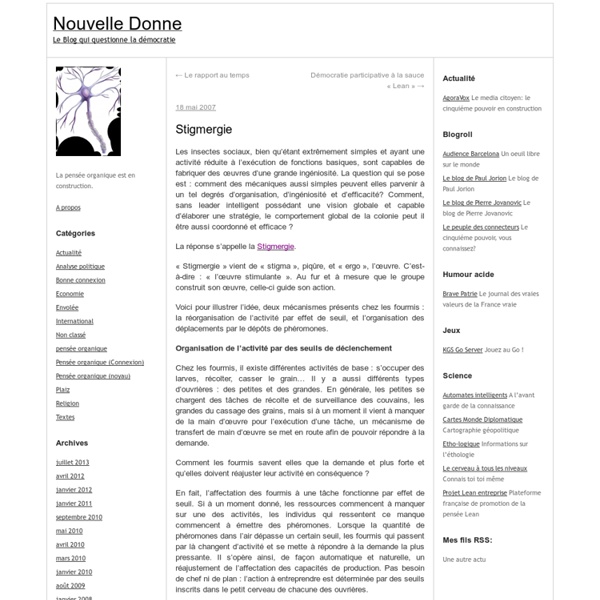The Stigmergic Revolution
It was long believed that the queen played a central role in the complex social order of an ant colony, through the exercise of direct command and control over her subjects. Not so. Biologist Pierre-Paul Grasse coined the term “stigmergy” for the anthill’s social organization There is no central coordination, no hierarchy, no administrative mechanism. Each ant’s behavior is entirely spontaneous and self-directed, as it responds independently to the chemical trail markers left by other ants. Mark Elliot, whose doctoral dissertation is probably the best study on the subject to date, applied the term “stigmergy” to any form of human socialization in which coordination is achieved not by social negotiation or administration or consensus, but entirely by independent individual action against the background of a common social medium. Eric Raymond, writing on the open source software community, called it the “Bazaar” model. In the words of Neo, in “The Matrix”: Translations for this article:
La stigmergie: un nouveau modèle de gouvernance collaborative
Si le modèle concurrentiel crée des redondances et gâche des ressources sur la protection des idées, la publicité et autre, le modèle coopératif gâche beaucoup de temps et de ressources à discuter et à discuter les discussions. Entre ces deux modèles, la stigmergie, une nouvelle méthode de gouvernance inspirée du mode d’organisation des insectes sociaux, pourrait offrir un modèle alternatif plus adapté à la collaboration dans des grands groupes. C’est quoi la stigmergie ? Définition de la stigmergie par Wikipédia : Application du modèle stigmergique aux organisations La théoricienne Heather Marsh a écrit un article remarquable sur l’application de principes issus de la stigmergie à la collaboration dans des grands groupes et comme une méthode de gouvernance alternative à mi-chemin entre les organisations fonctionnant sur un modèle de compétition celles fonctionnant sur un modèle de coopération. Voici une copie de l’article traduit. Stigmergie Le problème des organisations actuelles Nœuds
Stigmergic self-organization and the improvisation of Ushahidi | manwithoutqualities
Here are some excerpts from Janet’s fascinating paper. In late 2007 in Kenya, US educated Kenyan journalist Ory Okolloh had become one of the main sources of information about the election and the violence that broke out soon after. Because of the government‟s ban on live reporting and censorship of the mainstream media, Okolloh solicited information about incidents of violence from ordinary people in the form of comments posted on her personal blog. The mainstream media was not reporting on the violence because of the government ban, and Okolloh was quickly overwhelmed by the numbers of emails and messages that she received. In order to focus on the “immediate need to get the information out”, in early January Okolloh posted a request on her blog for help to develop a website where people could post anonymously online or via mobile phone text messages, the most accessible type of communications technology in Kenya. Like this: Like Loading...
Du Tag au Like: La pratique des folksonomies pour améliorer ses méthodes d ... - Olivier Le Deuff - Google Books
Stigmergy
Kind people have stigmergically translated this article into German, French, and Spanish. This article is part of a series now incorporated into : ‘Binding Chaos’. Stigmergy is a mechanism of indirect coordination between agents or actions. The principle is that the trace left in the environment by an action stimulates the performance of a next action, by the same or a different agent. In that way, subsequent actions tend to reinforce and build on each other, leading to the spontaneous emergence of coherent, apparently systematic activity. Stigmergy is a form of self-organization. A personality based system can never allow for mass collaboration on a global scale without representation such as that seen in organizations like the United Nations. Currently, the typical response to a situation which requires an action is to create a noun, in the form of a committee, commission, organization, corporation, ngo, government body, etc. Most systems are now run by competitive organizations. Nodes
The Desktop Regulatory State
The home of stigmergic systems
Biological system design
From the CD-ROM "Concepts and strategies" by Peter Small Modular route to complexity The ideas for creating stigmergic systems for the Web originated during the writing of the two books Lingo Sorcery and Magical A-Life Avatars (written for multimedia designers who wanted to learn how to use lists and objects). The central theme of these books was to show how object oriented programming techniques can be used to develop products that went beyond a developer's imagination. It was found that designing systems in this way, resulted in productions that went not only beyond the designer's imagination, but also beyond the designer's ability to comprehend the growing complexity that begins to emerge. It soon became clear that we were dealing with something far more exciting than mere computer programming; we were entering the esoteric world of chaos and complexity theory. Amazingly, this did not lead to the design of large, complicated programs. Objects Understanding objects Creating a new generation
Acta Astronautica - Stigmergy based behavioural coordination for satellite clusters
Abstract Multi-platform swarm/cluster missions are an attractive prospect for improved science return as they provide a natural capability for temporal, spatial and signal separation with further engineering and economic advantages. As spacecraft numbers increase and/or the round-trip communications delay from Earth lengthens, the traditional “remote-control” approach begins to break down. It is therefore essential to push control into space; to make spacecraft more autonomous. An autonomous group of spacecraft requires coordination, but standard terrestrial paradigms such as negotiation, require high levels of inter-spacecraft communication, which is nontrivial in space. This article therefore introduces the principals of stigmergy as a novel method for coordinating a cluster. After outlining the system, an analysis of some crucial parameters such as communications overhead and number of spacecraft is presented to demonstrate scalability. Keywords Copyright © 2009 Elsevier Ltd.



